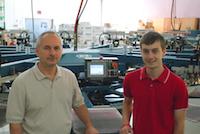by Ron Hopkins, NuArc Product Manager
One of the most overlooked tools in a screen print shop is also one of the most important. After all, the exposure unit is where the coated screen and the image come together. Any detail that is lost there will be lost from the final product.
Why are screen exposure systems so underappreciated? One reason is that the benefits of exposure systems are hard to quantify. It’s much easier to quantify the benefits of a new automatic press, where the productivity in substrates per hour is easy to calculate, and where it’s easy to assume that added color capacity will result in additional business. Since productivity is often valued more highly than quality, it’s easy to see why the screen exposure system is often an afterthought. However, neglecting quality—like neglecting preventive maintenance—comes at a price. If your customer finds a better deal elsewhere, you may still find a way to hang onto the business—or eventually get it back. However, if your customer is dissatisfied with the overall quality of the finished product, it’s unlikely you’ll be able to save the account. Your customer will probably assume you’re doing the highest quality work you’re capable of. Even if it’s assumed you can do better, the customer will not be happy that you haven’t.
Many screen printers start small and get complacent with their level of quality, even as they get larger and more productive. Many screen printers start off in a garage or basement. Many of these start-ups begin with a combination of used and homemade equipment. Because of cost, the exposure unit is often homemade. When startup funds are tight, resourceful people often turn to common, inexpensive light sources, including grow lights, aquarium lights, quartz halogen lamps, mercury vapor lamps, and metal-halide warehouse lights. Others start out with entry-level commercial exposure units. Since each of these is capable of exposing a usable screen, is there any benefit to the manufactured units available today? The answer is an unequivocal yes, and the benefits can be huge. That’s because there’s a big difference in the quality and consistency of a better light source, especially one that’s equipped with a light integrator and a good vacuum system.
So what should you look for in a light source?
Point Light Source
The ideal light source is one where all of the light is collimated (all light rays are parallel to each other). This lessens the chance of undercutting. In other words, each ray of light should be perpendicular to the film and screen. If the rays come off the lamp at various angles, light particles can get between the edges of the image on the film and the emulsion on the screen, resulting in lost detail and reduced sharpness. The best results come from combining a point light source with a well-designed reflector.
UV Light Source
All UV light sources are not the same, and light output should be matched to the requirements of the emulsion. Emulsions respond best to a specific range of UV light, and there is quite a difference between a metal halide lamp designed to expose screens and a metal halide lamp used to light a parking lot. While there are special UV Fluorescent lamps that emit light waves in the right spectral range for emulsions, several lamps are required to cover a screen. Since the light, therefore, comes from several directions, collimation is lost and undercutting becomes a problem.
The results produced by any multiple-light source are inferior to a quality Metal Halide, point light source. Some people lump Quartz Halogen in with point light sources, but Quartz Halogen is not a good light source for exposing screens because it puts out virtually no UV light, the most effective type of light for exposing emulsions. Mercury Vapor, another type of light source, worked well in the 1970’s, but it’s not a good match for today’s emulsions.
Consistency and Control
For a good quality light source to be effective, it needs to produce the same results on every exposure. One of the best devices to ensure consistently exposed screens is the Light Integrator. It has the ability to measure the quantity of light reaching the screen, and to adjust the exposure in order to compensate for minor voltage fluctuations. It also compensates for aging lamps, which are prone to gradually declining output levels. The end result is that each screen will see the correct amount of light each and every time.
Vacuum
Similar to a Point Light Source, a good vacuum is a critical element in holding fine detail by helping to eliminate undercutting. The vacuum is another item often left off homemade units. In an attempt to compensate for the missing vacuum blanket, some screen printers use weights to hold the film against the screen. However, this approach is no match for a good vacuum system. A vacuum system with fifteen inches of mercury develops 3,775 lbs of pressure, holding the screen and film evenly together on a 23” x 31” screen! That kind of pressure is hard to match with plywood and weights!
The Critical Element
A good quality screen exposure unit is the critical element in supplying your presses with consistent, high-quality screens. This reduces the number of screens that have to be remade, while reducing the number of times that you run an inferior job because there is simply not time to make another screen and still meet the deadline. It also reduces the number of customer complaints and lost business due to poor-quality prints. The sad fact is that if you start with a poor quality light source without a vacuum system, there will never be enough time to shoot a high-quality screen because it can’t be done.
Shops are getting what they may consider “good enough” screens every day from a variety of exposure units, both manufactured and homemade. The exposed screens seem adequate because when someone keeps seeing the same screens produced the same way day after day, they have no other point of reference. How much better is HDTV than regular TV? There’s no contest, but if you haven’t seen HDTV, you can’t appreciate the difference. That difference is similar to the difference between low-end and higher-end exposure equipment. A good Metal Halide point light source, a good quality vacuum system with programmable time settings, and a Light Integrator will take you to another level.
If you’re still using a homemade or low-end exposure system, you need to reject “good enough” complacency and look at the screen exposure unit as one of the most important pieces of equipment in the shop; it plays a major role in the quality of the finished print. A common misconception is that the main reason for moving up from a low-end multiple light source to a high-end Metal Halide unit is for faster exposures. While exposures will usually be faster, the main reason is to raise the quality and consistency of the finished product.
The bottom line is that a better exposure system will give you a consistently higher quality product. As you grow your business by adding presses, by purchasing your first automatic press, or by taking on specialty work, take a look in the screen room and make sure you’re turning out the best screens possible. The benefits of a high-quality exposure system may seem intangible, but they’re real. A decision to invest in quality exposures is one you will never regret.
NuArc has an exposure unit to suit the needs of any screen printer. Click on the links below to find the system that’s right for you.
First Light
First Light is NuArc’s versatile and affordable tabletop direct screen exposure system. With its convenient and economical approach to direct screen exposure, First Light is the perfect unit for startup manual screen shops.
Mega-Light
Mega-Light is the versatile and affordable direct screen exposure system that’s perfect for any startup manual screen shop. Available as a tabletop model or as an optional stand-mounted unit, Mega-Light offers a convenient, economical approach to direct screen exposure.
MSP 2125
The exceptionally affordable MSP 2125 features NuArc’s patented instant-start power technology, which reduces glass temperature, power consumption, and environmental heating effects. With a 53 x 64 cm (21” x 25”) maximum screen frame size, it’s an ideal choice for those who print small substrates, but demand the same high quality found in NuArc’s larger exposure units.
MSP 3140
MSP 3140 features NuArc’s patented instant-start power technology, which reduces glass temperature, power consumption, and environmental heating effects. With a 79 x 104 cm (31" x 40") maximum screen frame size, it’s an ideal choice for those entering automatic printing and for quality-conscious printers in manual environments. MSP 3140 is designed for those seeking superior performance at an affordable price.
Tri-Light
Tri-Light features NuArc’s patented instant-start power technology, which reduces glass temperature, power consumption, and environmental heating effects. With its 107 x 152 cm (42" x 60") maximum screen frame size; fast, powerful light source; and exceptional repeatability, Tri-Light is perfect for high-volume operations.
Tri-Light ST
Tri-Light ST is a larger, shuttered-light version of NuArc’s popular Tri-Light Exposure System. With its 132 x 152 cm (52” x 60”) maximum screen frame size; fast, powerful light source, and exceptional repeatability, Tri-Light ST is perfect for high-volume operations.
Tri-Light CTS
Tri-Light CTS is the dual-purpose version of NuArc’s popular Tri-Light ST Exposure System. It produces the same exceptional results on conventional screens, but it also exposes screens that have been generated by a computer-to-screen (CTS) system, making it the logical choice for those using both screen types—and for conventional screen users planning for the future.
Helios T
NuArc’s largest textile screen exposure system enables high-volume screen printers to maximize productivity by exposing numerous screens at once. Helios T also offers the ultimate in computerized operation.
6K/3K
NuArc’s 6K & 3K multi-spectrum metal-halide lamps provide instant-start, shutterless operation for all freestanding and wall-mounted vacuum frames. The 6K & 3K provide uniform coverage on direct, capillary, and indirect emulsions.
SPVF
NuArc’s SPVF Direct Screen Vacuum Frames are sized for large and multiple screen exposures. These versatile vacuum frames can be rotated in a 360° arc. This makes it possible to load screens while the SPVF vacuum frame is in a horizontal position, and then rotate the frame to a vertical position.

About the Author
- Email Address ron.hopkins@nuarc.com




